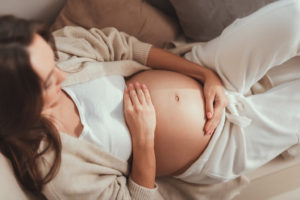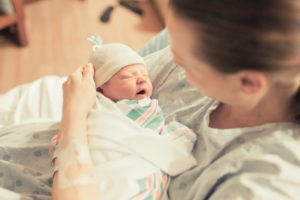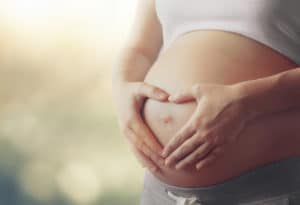About one in three pregnant women experience preterm labor in the weeks before the expected delivery date. These may be genuine preterm labor pains or so-called practice contractions. If it is true preterm labor, various measures can be used to prevent premature birth.
Table of contents
What Are Preterm Labor Contractions?
Preterm labor is labor that causes contractions of the cervix (neck of the womb) before the end of the 37th week of gestation, resulting in an opening of the cervix. Only these contractions acting on the cervix are considered true preterm labor.
To be distinguished from these are the so-called wild labor pains, low labor pains, or practice labor pains. You often feel that your abdomen is hardening. Your uterus is already training for an emergency. During the entire pregnancy, but especially in the phase before the birth, light uterine contractions often occur.
If you are not sure whether you are just having practice contractions or real contractions, it is best to have yourself examined by a doctor.
If you experience contractions in quick succession over a long period of time (more than three times an hour) and feel a pulling sensation in your abdomen, these do not practice contractions, but real preterm contractions that can lead to an opening of the cervix. In this case, you should see a doctor immediately.
In the worst case scenario, preterm labor can lead to the birth of an underweight baby that may have little chance of survival.
Uterine Dilation During Pregnancy
Uterine dilation during pregnancy can also cause pain in the uterine ligaments. Many pregnant women feel a pulling in the groin area that feels similar to a pulled or sore muscle.
The pain of the uterine ligaments usually occurs when the pregnant woman stands up or stretches. This pain is also often felt when exercising during pregnancy.
What Factors Can Trigger Early Labor?
Premature labor can be triggered by physical and psychological causes. Both illnesses of the mother or the child, as well as stress and psychological strain, can trigger premature labor. However, premature labor can also be an unspecific reaction to a general overload.
Preterm labor usually occurs without warning, but it can also be triggered by certain risk factors. Factors that trigger labor include:
- Premature rupture of the membranes.
- Chorioamnionitis (an acute bacterial infection).
- Uterine inflammation caused by group B streptococci.
- Multiple pregnancy.
- Anomalies of the fetus or placenta.
- Anomalies of the uterus.
- Inflammation of the renal pelvis (pyelonephritis).
- Various venereal diseases.
There is an increased risk with previous preterm birth and cervical insufficiency.
What Are The Treatment Options For Preterm Labor?
If too much stress or physical exertion is the cause of preterm labor, in some cases a few days of rest, relaxation, and physical rest are enough to stop preterm labor again. Additionally, you should refrain from sexual intercourse because it can trigger contractions.
Magnesium supplements are often used to relax the uterus. They have a relaxing effect on the uterine muscles. If a bacterial infection is involved, it is treated with antibiotics. If the contractions do not subside despite all measures and the contractions affect the cervix, hospitalization may be necessary.
Treatment With Contraceptives
If the cervix has already opened, there is a risk of premature birth. If the water has not yet broken, everything possible will be done in the hospital to prevent premature birth.
Usually, pregnant women are first treated with cortisone. This is to accelerate the maturation of the fetal lungs. In addition, drugs to inhibit labor (tocolytics) are often used. The pregnant woman is advised to take physical rest.
Labor-inhibiting drugs should only be used between the 24th and 34th SSW. In this case, the duration of use should not exceed two days. Studies have shown that a longer period of use does not lead to a lowering of the uterus between the 24th and 34th week of pregnancy.
Many labor inhibitors not only affect the uterine muscles but also reduce the tension of other muscles. This weakens the circulation and increases the pulse rate. Therefore, most tocolytics should not be taken if you have heart disease.
The following are used as labor inhibitors:
- Magnesium sulfate.
- Calcium antagonist.
- Prostaglandin inhibitor.
Magnesium In Pregnancy
Premature labor can be alleviated by taking magnesium during pregnancy. Muscle contractions may occur more easily with a deficiency of magnesium. The recommended daily dose for pregnant women is about 310 milligrams of magnesium.
Magnesium is also found in many foods such as fruits, vegetables, whole grains, dairy products, legumes (for example, beans, peas, lentils) and nuts.
In summer, special attention must be paid to the magnesium balance, because the body loses many minerals through sweating. Lost minerals, as well as magnesium, must then be replaced. When buying mineral water, pay attention to the magnesium content on the label!
Cervical Closure: The Cerclage
If the cervix has already opened, a plastic band is wrapped around the cervix under local anesthesia (peridural anesthesia) and pulled tight. This cervical closure is called a “cerclage”. The cervix remains closed until birth.
A cerclage can be placed from the 15th week of pregnancy. After the 28th week, the cerclage no longer makes sense. About two weeks before the calculated date of birth, or even if the contractions can no longer be stopped, the cerclage is opened.
In each individual case, it is examined whether a cerclage is useful or not. Many scientific studies did not provide evidence of the benefit of a cerclage for the prevention of preterm birth.
As an alternative to cerclage, the cerclage pessary is used. Instead of the plastic band, a soft rubber ring is pushed into the vagina and placed over the cervix. This is to reduce the strain on the cervix. The cerclage pessary can be inserted without anesthesia.
In the following cases, total cervical closure is an option:
The pregnant woman has already had several premature births or miscarriages in which an infection was the cause. The cause of preterm labor is unexplained.
The cervix is completely sutured shut to prevent bacteria from ascending into the uterus.
Usually, the cervix is closed between the 12th and 16th week of pregnancy. The cerclage is removed shortly before the expected delivery date.
Which Hospitals Are Suitable?
If a hospital does not specialize in preterm birth, it may not admit pregnant women until 37 weeks of pregnancy. Premature babies have the best chance of survival up to 36 weeks gestation in hospitals with well-equipped neonatal units. Small, less specialized maternity hospitals are less suitable.
How Are Preterm Labor Diagnosed?
The first thing the gynecologist checks is whether the cervix is open and how wide it is open. The length of the cervix is determined during an ultrasound examination. The ultrasound examination also allows a look at the baby. With the help of the labor recorder (cardiotocograph, CTG), the baby’s heart sounds and labor strength and frequency are recorded.
Even if you are diagnosed with preterm labor during this examination, it does not automatically indicate that you are about to give birth. The cause of preterm labor must also be considered.
How Do You Recognize Exercise Contractions?
Exercise contractions are indicated, for example, by a firming of the abdomen. Many pregnant women find this condition uncomfortable, but there is usually no pain. Some pregnant women report menstrual-like pain.
With exercise contractions, the contractions typically come fairly regularly. However, the intervals between exercise contractions are long: the uterine muscle contracts at intervals of several hours or one to three times an hour. Lying down and warmth usually cause exercise contractions to subside.
Exercise contractions are divided into Alvarez contractions and Braxton-Hicks contractions:
Alvarez Contractions
Short and undulating exercise contractions. These are relatively weak and irregular. Only small areas of the uterus are tightened. Braxton-Hicks contractions.
More frequent and stronger contractions in which larger parts of the uterine muscles contract.
What Are Descending Contractions?
Descending contractions do not open the cervix yet. Descending contractions cause the baby to sink deeper into the mother’s pelvis. Ideally, the baby’s head gradually moves toward the birth canal with a slight rotation. Descending contractions are usually felt after the 36th week of pregnancy.
This means that they occur later than the exercise contractions. First-time mothers feel the descending contractions much earlier than pregnant women who have already delivered one or more children. In some women, the baby’s head does not move into the pelvis until the birth begins.
In this case, it is not possible to clearly differentiate between descending contractions and labor pains. The onset of the descending contractions does not allow any conclusions to be drawn about the beginning of the birth.
Descending contractions can occur at ten-minute intervals or with breaks of several hours to several days. Sinking contractions feel different for each pregnant woman. Often, pregnant women report a feeling of tightness; rarely do they complain of real pain. Some feel an uncomfortable pulling sensation that may be accompanied by pain. The pain may radiate to the back and thighs.
Lowering contractions can be relieved well with heat. The pain usually decreases if you lie down in a warm bathtub or put a hot water bottle on your belly.
In some women, the only noticeable change in the shape of the abdomen is a contraction. The abdomen sits lower, making the upper abdominal cavity less constricted. Complaints such as heartburn or shortness of breath improve as a result.
The lower position of the baby leads to increased pressure on the bladder. An increased urge to urinate may also indicate that the lowering contractions had already started.
When Should You Go To The Doctor For Contractions?
If you have regular, painful contractions that are not relieved by heat, you should definitely see the doctor. This could be a case of preterm labor. If you are closer to your due date, it is probably real labor. You should not confuse these with training contractions or low contractions.
You can find out what else you need to know about labor at https://www.practicalmommy.com/wissenswertes-ueber-wehen/.
Conclusion
If you experience contractions before your due date and you are not sure if they are true preterm labor or just practice contractions, you should see a doctor. There are many measures that can mitigate preterm labor and thus prevent premature birth.












2 thoughts on “You Can Recognize Preterm Labor By These Signs”